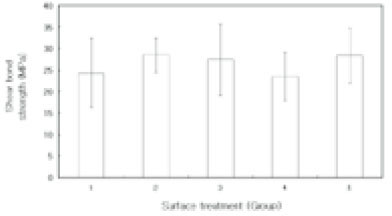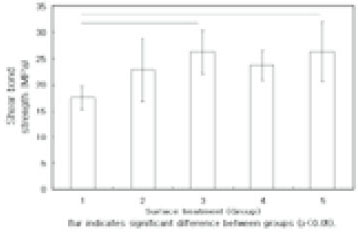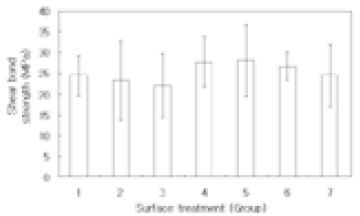J Korean Acad Conserv Dent.
2002 Nov;27(6):569-576. 10.5395/JKACD.2002.27.6.569.
Shear bond strength of repaired composite resin restorations
- Affiliations
-
- 1Department of Conservative Dentistry, College of Dentistry, DSRI, Chonnam National University, Korea.
- 2Department of Dentistry, College of Medicine, Seonam University, Korea.
- KMID: 1987315
- DOI: http://doi.org/10.5395/JKACD.2002.27.6.569
Abstract
- This study was performed to evaluate the interfacial shear bond strength of base (direct and indirect) and repair composites with aging and surface treatment methods. Direct composite resin specimens (Charisma(R), Heraeus Kulzer, Germany) were aged for 5 min, 1 hour, 24 hours, and 1 week in 37degrees C distilled water before surface treatment, and then divided into five groups: Group 1, grinding; Group 2, grinding and application of bonding agent; Group 3, grinding, etching with 37% phosphoric acid for 30sec, and application of bonding agent; Group 4, grinding, etching with 37% phosphoric acid for 30sec, silane treatment, and application of bonding agent; Group 5, grinding, etching with 4% hydrofluoric acid for 30sec, silane treatment, and application of bonding agent. Indirect composite resin specimens (Artglass(R), Heraeus Kulzer, Germany) were aged for 1 week in 37degrees C distilled water and divided into seven groups: Group 1 - Group 5, equal to Charisma specimens; Group 6, grinding, etching with 37% phosphoric acid for 60sec, silane treatment, and application of bonding agent; Group7, grinding, etching with 4% hydrofluoric acid for 60 sec, silane treatment, and application of bonding agent. The repair material(Charisma(R)) was then added on the center of the surface (5 mm in diameter, 5 mm in height). The shear bond strength was tested and the data was analyzed using one-way ANOVA and the Student-Newman-Keuls test. The following conclusions were drawn. 1. The shear bond strength of Charisma(R) specimens aged for 1 hour was significantly higher in Group 2 and Group 5 than in Group 1 (p<0.05), and that of Charisma(R) specimens aged for 1 week was significantly higher in Group 3 and Group 5 than in Group 1 (p<0.05). No significant difference was found in the bond strength of specimens aged for 5 min and 24 hours. 2. In Group 2 of the Charisma(R) specimens, there was significant difference between the bond strength of 24 hours and that of 1 week (p<0.05). 3. In Group 4 of the Charisma(R) specimens, the shear bond strength of specimens aged for 24 hours was significantly higher than the others(p<0.05). 4. There was no significant difference between the shear bond strength of the Artglass(R) specimens. 5. Most of the Charisma(R) specimens showed cohesive fractures. Artglass(R) specimens that were etched with acid (phosphoric or hydrofluoric) for 30 sec showed more cohesive fractures.
MeSH Terms
Figure
Cited by 1 articles
-
The study of fractural behavior of repaired composite
Sang-Soon Park, Wook Nam, Ah-Hyang Eom, Duck-Su Kim, Gi-Woon Choi, Kyoung-Kyu Choi
J Korean Acad Conserv Dent. 2010;35(6):461-472. doi: 10.5395/JKACD.2010.35.6.461.
Reference
-
1. Chan DCN, Lemake KC, Howell ML, Barghi N. The effect of microabrasion on restorative materials and tooth surface. Oper Dent. 1996. 21:63–68.2. Shahdad SA, Kennedy JG. Bond strength of repaired anterior composite resins: an in vitro study. J Dent. 1997. 26:685–694.3. Lewis G, Johnson W, Martin W, Canerdy A, Claburn C, Collier M. Shear bond strength of immediately repaired light-cured composite resin restorations. Oper Dent. 1998. 23:121–127.4. Miranda FJ, Duncanson MG, Dilts WE. Interfacial bonding strengths of paired composite systems. J Prosthet Dent. 1984. 51:29–32.
Article5. Davis BR, Millar BJ, Wood DJ, Budd NL. Strength of secondary-cured resin composite inlay repairs. Quintessence Int. 1997. 28:415–419.6. Kang HS, Choi HY. A Study on the Bond Strength of Repair Resin to the Surface Treated Composite Resins. J Korean Acad Conserv Dent. 1995. 20:487–507.7. Boyer DB, Chan KC, Reinhardt JW. Build-up and repair of light-cured composites: bond strength. J Dent Res. 1984. 63:1241–1244.
Article8. Vankerckhoven H, Lambrechts P, Van Beylen M, Davidson CL, Vanherle G. Unreacted methacrylate groups on the surfaces of composite resins. J Dent Res. 1982. 61:791–795.
Article9. Lloyd CH, Baigrie DA, Jeffrey IW. The tensile strength of composite repairs. J Dent. 1980. 8:171–177.
Article10. Forsten L, Valiaho ML. Transverse and bond strengths of restorative resins. Acta Odontol Scand. 1971. 29:527–537.11. Reisbick MH, Brodsky BA. Strength parameters of composite resins. J Prosthet Dent. 1971. 26:178–185.
Article12. Boyer DB, Chan KC, Torney DL. The strength of multilayer and repaired composite resin. J Prosthet Dent. 1978. 39:63–67.
Article13. Chiba K, Hosoda H, Fusayama T. The addition of an adhesive composite resin to the same material: bond strength and clinical techniques. J Prosthet Dent. 1989. 61:669–675.
Article14. Turner CW, Meiers JC. Repair of an aged, contaminated indirect composite resin with a direct, visible light-cured composite resin. Oper Dent. 1993. 18:187–194.15. Brosh T, Pilo R, Bichacho N, Blutstein R. Effect of combination of surface treatments and bonding agents on the bond strength of repaired composites. J Prosthet Dent. 1997. 77:122–126.
Article16. Puckett AD, Holder R, O'Hara JW. Strength of posterior composite repairs using different composite/bonding agent combinations. Oper Dent. 1991. 16:136–140.17. Swift EJ Jr, LeValley BD, Boyer DB. Evaluation of new methods for composite repair. Dent Mater. 1992. 8:362–365.
Article18. Soderholm KJ, Roberts MJ. Variables influencing the repair strength of dental composites. Scand J Dent Res. 1991. 99:173–180.
Article19. Swift EJ, Wilder AD, May KN, Waddell SL. Shear bond strengths of one-bottle dentin adhesives using multiple applications. Oper Dent. 1997. 22:194–199.20. Barkmeier WW, Erickson RL. Shear bond strength of composite to enamel and dentin using Scotchbond Multi-Purpose. Am J Dent. 1994. 7:175–179.21. Gwinnett AJ, Yu S. Shear bond strength, microleakage and gap formation with fourth generation dentin bonding agents. Am J Dent. 1994. 7:312–314.22. Kanca J III. Resin bonding to wet substrate. I. Bonding to dentin. Quintessence Int. 1991. 23:39–41.23. Crumpler DC, Bayne SC, Sockwell S, Brunson D, Roberson TM. Bonding to resurfaced posterior composites. Dent Mater. 1989. 5:417–424.
Article24. Pounder B, Gregory WA, Powers JM. Bond strenths of repaired composite resins. Oper Dent. 1987. 12:127–131.25. Eli I, Liberman R, Levi N, Haspel Y. Bond strength of joined posterior light-cured composites: comparison of surface treatments. J Prosthet Dent. 1988. 60:185–189.
Article26. Eliades GC, Caputo AA. The strength of layering technique in visible light-cured composites. J Prosthet Dent. 1989. 61:31–38.
Article27. Azarbal P, Boyer DB, Chan KC. The effect of bonding agents on the interfacial bond strength of repaired composites. Dent Mater. 1986. 2:153–155.
Article28. Saunders WP. Effect of fatigue upon the interfacial bond strength of repaired composite resins. J Dent. 1990. 18:158–162.
Article29. Bouschlicher MR, Reinhardt JW, Vargas MA. Surface treatment techniques for resin composite repair. Am J Dent. 1997. 10:279–283.30. Matsumura H, Hisamatsu N, Atsuta M. Effect of unfilled resins and a silane primer on bonding between layers of a light-activated composite resin veneering material. J Prosthet Dent. 1995. 73:386–391.
Article31. Kula K, Nelson S, Thompson V. In vitro effect of APF gel on three composite resins. J Dent Res. 1983. 62:846–849.
Article32. Kula K, Nelson S, Kula T, Thompson V. In vitro effect of acidulated phosphate fluoride gel on the surface of composites with different filler particles. J Prosthet Dent. 1986. 56:161–169.
Article33. Aschheim KW, Dale BG. Composite resin: indirect technique restorations. Esthetic Dentistry. 2001. 2nd ed. St. Louis: Mosby Co.;97–111.
Article
- Full Text Links
- Actions
-
Cited
- CITED
-
- Close
- Share
- Similar articles
-
- The shear bond strength of two adhesives bonded to composite resin and glass ionomer cement restorations
- Evaluation of shear bond strengths of gingiva-colored composite resin to porcelain, metal and zirconia substrates
- Effect of thermocycling on shear bond strength and mode of failure of bonded retainer using flowable composite resin
- The effect of different bonding systems on shear bond strength of repaired composite resin
- Effect of delayed time, surface treatment, and repair material on shear bond strength of repaired bis-acryl composite resin







